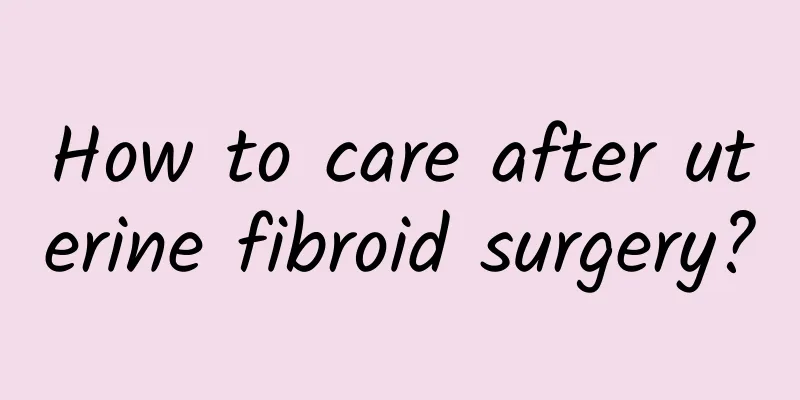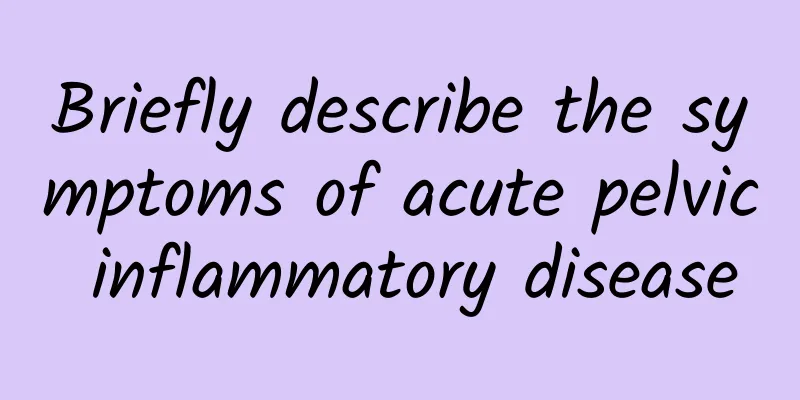How to care after uterine fibroid surgery?

|
Uterine fibroids are a common gynecological disease. Uterine fibroids require surgery when necessary. Do you know how to care for yourself after uterine fibroids surgery? Let's listen to the expert's introduction. How to care after uterine fibroid surgery? Experts introduce as follows: 1. Postoperative cleaning: After discharge, the incision on the abdominal wall should be kept dry. Bathing is prohibited after one week (bathtub bath is prohibited). Because the sutures have just been removed and the needle holes have not healed completely, and the scabs on the incision have not fallen off, bathing is not suitable. Of course, the skin on the whole body still needs to be kept clean, preferably with a sponge bath, and wash the perineum every night or after defecation. 2. Possible abnormal symptoms: A. Vaginal bleeding: For those who undergo intramural myoma or submucosal myoma removal, there will be wounds on the uterine wall, which will cause a small amount of vaginal bleeding after the operation. Generally, it will not exceed 10 days and is normal. If it exceeds half a month, you should go to the hospital for examination; B. Generally, there will be no bleeding after subtotal resection. However, if the cervical margin is high, there may be a little vaginal bleeding on the day of menstruation every month. The amount depends on the height of the cervical margin. If the margin is high and there is more endometrium left, there will be more vaginal bleeding. On the contrary, there will be less vaginal bleeding. C. After total hysterectomy, there may be a small amount of yellow or bloody discharge in 10-15 days. You can observe it for a few days and it will subside naturally. If there is purulent discharge, it may be infection of the vaginal incision stump or vaginitis. You should go to the hospital for diagnosis and treatment, find out the cause and deal with it in time. If a patient with subtotal or total hysterectomy has a lot of vaginal bleeding, it may be due to suture rupture, and you should go to the hospital for emergency examination immediately. 3. Diet: After discharge, it is advisable to eat a light diet, a favorite, easily digestible high-protein, high-vitamin and high-mineral diet. Eat more vegetables and fruits to keep the bowels open, because constipation can easily cause the suture of the vaginal stump to become thinner, causing the risk of rupture and bleeding. 4. Pain care: A. Generally, you may still have slight pain at the incision when you are discharged from the hospital. It is normal to have a stabbing pain from time to time. If the pain is obvious, you need to check whether it is red and swollen to rule out the possibility of infection. If there is pus squeezed out, you need to go to the hospital for a dressing change. If it is just redness and swelling, you can buy an infrared bulb and install it on the base of a desk lamp. After properly placing it, irradiate the abdomen twice a day, 20 minutes each time, until you don't feel hot. B. Waist pain: Mild pain will generally get better after a few days of rest. If the pain is obvious, you need to go to the hospital to consult a doctor to rule out the sequelae left by anesthesia, and use some medicine if necessary. C. Pain during urination: Most patients will not have this symptom. A small number of patients may experience radiating pain in the lower abdomen during urination. This may be caused by surgery. Because the uterus is adjacent to the bladder, if there is adhesion in the pelvic cavity, the uterus will be separated from the bladder when it is removed. There may be slight abrasions, which will improve on its own after a few days. Usually, drink more boiled water, and urinate immediately when you feel the urge to urinate. Do not hold urine for too long. If there is pain at the urethral opening during urination, it may be caused by urinary tract infection. Mild cases can be cured by drinking more boiled water every day. Severe cases require further examination and treatment in the hospital. How to care after uterine fibroid surgery? The above content has been introduced in detail, I believe you have understood it. If you have other questions, please consult our online experts, who will answer you more professionally. Uterine fibroids topic: http://www..com.cn/fuke/zgjl/ |
<<: A brief discussion on the harm of moderate cervical erosion
>>: Which groups are susceptible to ovarian cysts?
Recommend
Study: Obesity between the ages of 30 and 39 may increase the risk of dementia! Young people need to prevent the three highs and metabolic syndrome
Everyone stays away from obesity. Besides the fac...
Are abortion medications safe?
Unexpected pregnancy is common in gynecological c...
Beware of the clinical manifestations of chronic pelvic inflammatory disease
Pelvic inflammatory disease is a common gynecolog...
What are the symptoms of female cervical erosion? Introduction to the important manifestations of female cervical erosion
Nowadays, more and more women are busy with work ...
Can I use suppositories after a miscarriage?
For a period of time after an abortion, the opera...
Can I eat mangoes if I have pelvic inflammatory disease? Yes.
Mango is one of the most delicious fruits and als...
Can I get pregnant if I have mild vaginitis? It is recommended to prepare for pregnancy after recovery
Although women with mild vaginitis can get pregna...
Will dysmenorrhea affect pregnancy?
According to a survey of women of childbearing ag...
What anti-inflammatory drugs should be taken after painless abortion? How many days should anti-inflammatory injections be taken for painless abortion?
Painless abortion is a safe and effective method ...
Overeating ruins weight loss efforts! Chestnuts increase satiety
When the autumn wind blows, chestnuts are in abun...
What are the methods for checking premature ovarian failure?
You should actively master the examination method...
Understanding the causes of threatened miscarriage
Threatened abortion is the early symptom before m...
What are the effects of adnexitis on female infertility?
Adnexitis is a common disease, and patients with ...
Acute and chronic adnexitis will have different degrees of symptoms
Acute and chronic adnexitis will have different d...
Does a small amount of pelvic fluid require treatment?
Does a small amount of pelvic fluid require treat...









